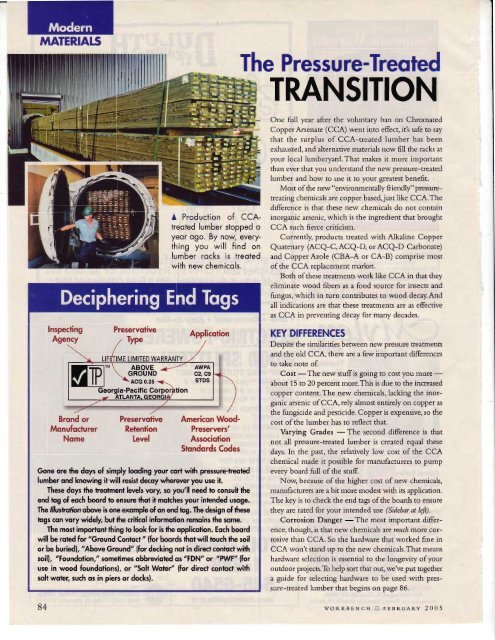Elegant Entry Divider - Wood Tools
Elegant Entry Divider - Wood Tools
Elegant Entry Divider - Wood Tools
Create successful ePaper yourself
Turn your PDF publications into a flip-book with our unique Google optimized e-Paper software.
E,YIAIERIAUi<br />
Preservolive<br />
ABOVE<br />
GROUND<br />
Preservolive<br />
Rebnfion<br />
level<br />
The Pressure-Treoted<br />
TRANSITION<br />
One full year efter the voluntary ban on Chromated<br />
CopperArsenate (CCA) went into effect, it's safe to say<br />
that the surplus of CCA-treated lumber has been<br />
exhausted, and alternative materials now fill the racks at<br />
your local lumberyard. That makes it more important<br />
than ever that you understand the new pressure-treated<br />
lumber and how to use it to your greatest benefit.<br />
Most of the new "envilonmentally friendly" pressuretreating<br />
chemicals are copper based,just like CCA.The<br />
difference is that these new chemicals do not contain<br />
A Production of CCAtreoted<br />
lumber stopped o CCA such fierce criticism.<br />
inorganic arsenic, which is the ingredient that brought<br />
yeor ogo. By now, everything<br />
you will find on Quatenary (ACQ-C, ACQ-D, or ACQ-D Carbonate)<br />
Currently, products treated with Alkaline Copper<br />
lumber rocks is treoted and CopperAzole (CBA-A or CA-B) comprise most<br />
wifh new chemicols. of the CCA replacement market.<br />
Both of these ffeaunents work like CCA in that they<br />
eliminate wood fibers as a food source for insects and<br />
fungus, which in turn contributes to wood decay.And<br />
all indications are that these ffeatments are as effective<br />
as CCA in preventing decay for many decades.<br />
Americon <strong>Wood</strong>-<br />
Preservers'<br />
Associofion<br />
Stundords Codes<br />
Crone qrc the doys of simply looding your cort with pressure-treobd<br />
lumber ond knowing it will rcsist decoy wherwer you use it.<br />
These doys the treotment lwels wry so you'll need to consulthe<br />
end tog of eoch boord to ensure thot it mqkhes your inbnded usoge.<br />
lhe illutraimobove is one exomple of on end tog. Ifte design of these<br />
bgs con vory widely, but fte criticol informofion remoins the some.<br />
T}e most imporbnt thing to look for is the opplicotion. Eoch boord<br />
will be roted for "Ground Conhct " (for boords thotwill buch the soil<br />
or be buriedl,<br />
'?bove Groundo (br decking not in direct conbct with<br />
soil), "Foundofion," somelimes obbreviohd os "FDN,, or ,,pWF,, for<br />
use in wood foundotions), or "Solt Wolero lfor direct contoct with<br />
soh wobr, such qs in piers or docksl.<br />
KEY DIFFERENCES<br />
Despite the similarities between new pressure ffeaffnenb<br />
and the old CCA, there are a few important differences<br />
to take note of.<br />
Cost -The new stuffis going to cost you<br />
about 15 to 20 percent more.This is due to the increased<br />
copper content.The new chemicals, lacking the inorganic<br />
arsenic of CCA, rely almost entirely on copper as<br />
the fungicide and pesticide. Copper is expensive, so the<br />
cost of the lumber has to reflect that.<br />
Varyrng Grades - The second difference is that<br />
not all pressure-treated lumber is created equal these<br />
days. In the past, the relatively low cost of the CCA<br />
chemical made it possible for manufacturers to pump<br />
every board full of the sruff.<br />
Now, because of the higher cost of new chemicals,<br />
manufacturers are a bit more modest with is application.<br />
The key is to check the end tags ofthe boards to ensure<br />
they are rated for your intended use (Sidebar at leJt).<br />
Corrosion Danger - The most important difference,<br />
though, is that new chemicals are much more corrosive<br />
than CCA. So the hardware that worked fine in<br />
CCA wont stand up to the new chemicals.That means<br />
hardware selection is essential to the longevity of your<br />
outdoor projecs.To he$ sort that out, we've put together<br />
a guide for selecting hardware to be used with pressure-treated<br />
lumber that begins on page 86.<br />
84<br />
woRKBENcH D FEBRUARy 2005












![Til]tl](https://img.yumpu.com/45878240/1/190x245/tiltl.jpg?quality=85)




